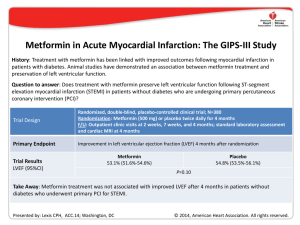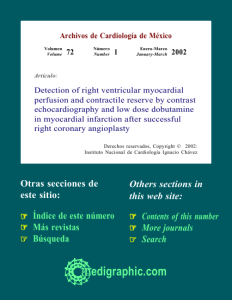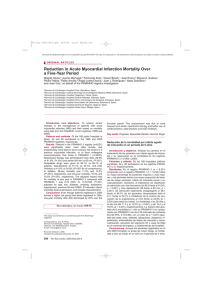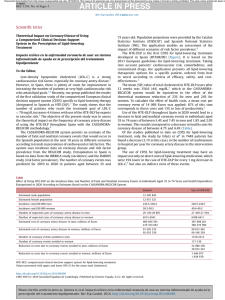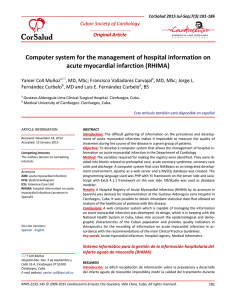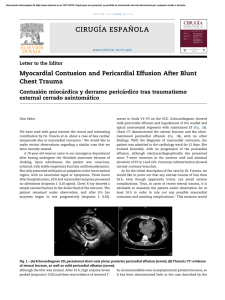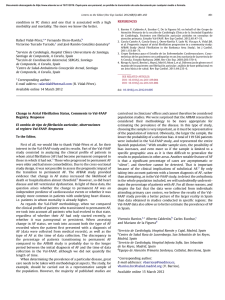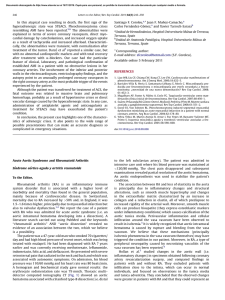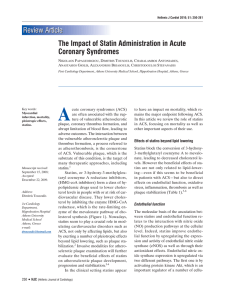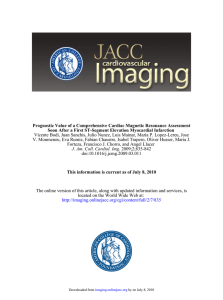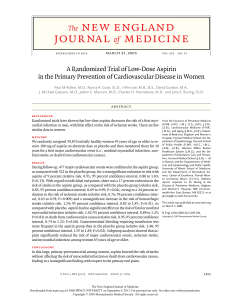Summary of the Clinical Studies Reported in the Annual
Anuncio
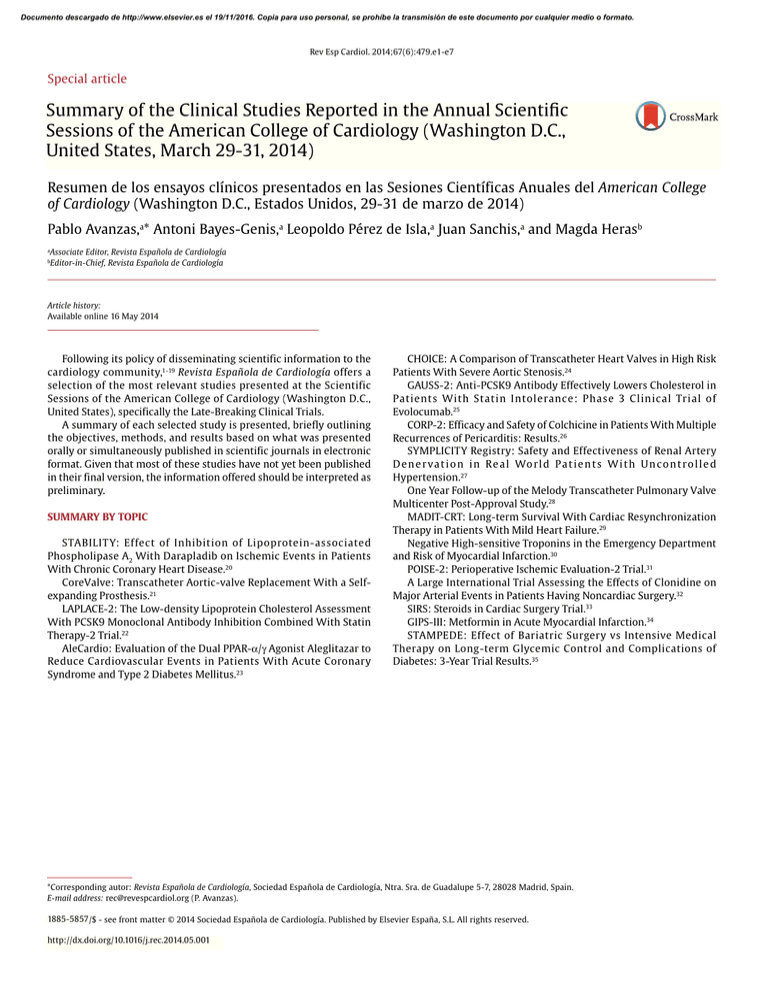
Documento descargado de http://www.elsevier.es el 19/11/2016. Copia para uso personal, se prohíbe la transmisión de este documento por cualquier medio o formato. Rev Esp Cardiol. 2014;67(6):479.e1-e7 Special article Summary of the Clinical Studies Reported in the Annual Scientific Sessions CollegeReported of Cardiology D.C., Sessions of the Summaryofofthe theAmerican Clinical Studies in the(Washington Annual Scientific United States, March 29-31, 2014) American College of Cardiology (Washington D.C., United States, March 29-31, 2014) Resumen de los ensayos clínicos presentados en las Sesiones Científicas Anuales del American College of Cardiology (Washington D.C., Estados Unidos, 29-31 de marzo de 2014) Pablo Avanzas,a* Antoni Bayes-Genis,a Leopoldo Pérez de Isla,a Juan Sanchis,a and Magda Herasb Associate Editor, Revista Española de Cardiología Editor-in-Chief, Revista Española de Cardiología a b Article history: Available online 16 May 2014 Following its policy of disseminating scientific information to the cardiology community,1-19 Revista Española de Cardiología offers a selection of the most relevant studies presented at the Scientific Sessions of the American College of Cardiology (Washington D.C., United States), specifically the Late-Breaking Clinical Trials. A summary of each selected study is presented, briefly outlining the objectives, methods, and results based on what was presented orally or simultaneously published in scientific journals in electronic format. Given that most of these studies have not yet been published in their final version, the information offered should be interpreted as preliminary. SUMMARY BY TOPIC STABILIT Y: Effect of Inhibition of Lipoprotein-associated Phospholipase A2 With Darapladib on Ischemic Events in Patients With Chronic Coronary Heart Disease.20 CoreValve: Transcatheter Aortic-valve Replacement With a Selfexpanding Prosthesis.21 LAPLACE-2: The Low-density Lipoprotein Cholesterol Assessment With PCSK9 Monoclonal Antibody Inhibition Combined With Statin Therapy-2 Trial.22 AleCardio: Evaluation of the Dual PPAR-α/γ Agonist Aleglitazar to Reduce Cardiovascular Events in Patients With Acute Coronary Syndrome and Type 2 Diabetes Mellitus.23 CHOICE: A Comparison of Transcatheter Heart Valves in High Risk Patients With Severe Aortic Stenosis.24 GAUSS-2: Anti-PCSK9 Antibody Effectively Lowers Cholesterol in Patients With Statin Intolerance: Phase 3 Clinical Trial of Evolocumab.25 CORP-2: Efficacy and Safety of Colchicine in Patients With Multiple Recurrences of Pericarditis: Results.26 SYMPLICITY Registry: Safety and Effectiveness of Renal Artery D e n e r va t i o n i n Re a l Wo r l d P a t i e n t s W i t h Un c o n t r o l l e d Hypertension.27 One Year Follow-up of the Melody Transcatheter Pulmonary Valve Multicenter Post-Approval Study.28 MADIT-CRT: Long-term Survival With Cardiac Resynchronization Therapy in Patients With Mild Heart Failure.29 Negative High-sensitive Troponins in the Emergency Department and Risk of Myocardial Infarction.30 POISE-2: Perioperative Ischemic Evaluation-2 Trial.31 A Large International Trial Assessing the Effects of Clonidine on Major Arterial Events in Patients Having Noncardiac Surgery.32 SIRS: Steroids in Cardiac Surgery Trial.33 GIPS-III: Metformin in Acute Myocardial Infarction.34 STAMPEDE: Effect of Bariatric Surgery vs Intensive Medical Therapy on Long-term Glycemic Control and Complications of Diabetes: 3-Year Trial Results.35 *Corresponding autor: Revista Española de Cardiología, Sociedad Española de Cardiología, Ntra. Sra. de Guadalupe 5-7, 28028 Madrid, Spain. E-mail address: [email protected] (P. Avanzas). 1885-5857 - see front matter © 2014 Sociedad Española de Cardiología. Published by Elsevier España, S.L. All rights reserved. 0300-8932/$ http://dx.doi.org/10.1016/j.rec.2014.05.001 http://dx.doi.org/10.1016/j.rec.2014.05.001 Documento descargado de http://www.elsevier.es el 19/11/2016. Copia para uso personal, se prohíbe la transmisión de este documento por cualquier medio o formato. e2 P. Avanzas et al. / Rev Esp Cardiol. 2014;67:479.e1–e7 Effect of Inhibition of Lipoprotein-associated Phospholipase A2 With Darapladib on Ischemic Events in Patients With Chronic Coronary Heart Disease: The STABILITY Trial20 Presented by Harvey D. White, Auckland, New Zealand. Background. Elevated lipoprotein-associated phospholipase A2 activity promotes the development of vulnerable atherosclerotic plaques, and elevated plasma levels of this enzyme are associated with an increased risk of coronary events. Darapladib is a selective oral inhibitor of lipoprotein-associated phospholipase A2. Methods. In a double-blind trial, we randomly assigned 15 828 patients with stable coronary heart disease to receive either once-daily darapladib (at a dose of 160 mg) or placebo. The primary end point was the time to cardiovascular death, myocardial infarction, or stroke. Secondary end points included the components of the primary end point as well as major coronary events (death from coronary heart disease, myocardial infarction, or urgent coronary revascularization for myocardial ischemia) and total coronary events (death from coronary heart disease, myocardial infarction, hospitalization for unstable angina, or any coronary revascularization). Results. During a median follow-up period of 3.7 years, the primary end point occurred in 769 of 7924 patients (9.7%) in the darapladib group and 819 of 7904 patients (10.4%) in the placebo group (hazard ratio [HR] in the darapladib group = 0.94; 95% confidence interval [CI], 0.85 to 1.03; P = .20). There were also no significant between-group differences in the rates of the individual components of the primary end point or in all-cause mortality. Darapladib, as compared with placebo, reduced the rate of major coronary events (9.3% vs 10.3%; HR = 0.90; 95%CI, 0.82- 1.00; P = .045) and total coronary events (14.6% vs 16.1%; HR, 0.91; 95% CI, 0.84-0.98; P = .02). Conclusions. In patients with stable coronary heart disease, darapladib did not significantly reduce the risk of the primary composite end point of cardiovascular death, myocardial infarction, or stroke. CoreValve: Transcatheter Aortic-valve Replacement With a Self-expanding Prosthesis21 Presented by David H. Adams, New York, New York, United States. Background. We compare d transcatheter aortic-valve replacement (TAVR), using a self-expanding transcatheter aorticvalve bioprosthesis, with surgical aortic-valve replacement in patients with severe aortic stenosis and an increased risk of death during surgery. Methods. We recruited patients with severe aortic stenosis who were at increased surgical risk as determined by the heart team at each study center. Risk assessment included the Society of Thoracic Surgeons Predicted Risk of Mortality estimate and consideration of other key risk factors. Eligible patients were randomly assigned in a 1:1 ratio to TAVR with the self-expanding transcatheter valve (TAVR group) or to surgical aortic-valve replacement (surgical group). The primary end point was the rate of death from any cause at 1 year, evaluated with the use of both noninferiority and superiority testing. Results. A total of 795 patients underwent randomization at 45 centers in the United States. In the as-treated analysis, the rate of death from any cause at 1 year was significantly lower in the TAVR group than in the surgical group (14.2% vs 19.1%), with an absolute reduction in risk of 4.9 percentage points (upper boundary of the 95%CI, −0.4; P < .001 for noninferiority; P = .04 for superiority). The results were similar in the intention-to-treat analysis. In a hierarchical testing proce dure, TAVR was noninferior with respect to echocardiographic indexes of valve stenosis, functional status, and quality of life. Exploratory analyses suggested a reduction in the rate of major adverse cardiovascular and cerebrovascular events and no increase in the risk of stroke. Conclusions. In patients with severe aortic stenosis who are at increased surgical risk, TAVR with a self-expanding transcatheter aortic-valve bioprosthesis was associated with a significantly higher rate of survival at 1 year than surgical aortic-valve replacement. The Low-density Lipoprotein Cholesterol Assessment With PCSK9 Monoclonal Antibody Inhibition Combined With Statin Therapy - 2 Trial: A Phase 3, Double-blind, Randomized, Placebo and Ezetimibe Controlled, Multicenter Study to Evaluate Safety, Tolerability and Efficacy of Evolocumab (AMG 145) in Combination With Statin Therapy in Subjects With Primary Hypercholesterolemia and Mixed Dyslipidemia - (LAPLACE-2)22 Presented by Jennifer Robinson, Thousand Oaks, California, United States. Background. Elevated low-density lipoprotein (LDL) cholesterol levels are associated with increased atherosclerotic cardiovascular disease risk. Statins are currently the first-line treatment for patients who would benefit from lowering LDL-cholesterol and atherosclerotic cardiovascular disease risk, though some high-risk patients have a less-than-anticipated response or are intolerant to statin therapy. Monoclonal antibodies that inhibit proprotein convertase subtilisin/kexin type 9, such as evolocumab, have been shown to decrease LDL-cholesterol in phase 2 clinical trials. Does treatment with evolocumab every 2 weeks or every month effectively lower LDL-cholesterol when combined with statin therapy in patients with hypercholesterolemia? Methods. Randomized, double-blind, placebo- and ezetimibecontrolled, multicenter study; N = 1896. Randomization: 1 of 24 arms comparing subcutaneous evolocumab (140 mg every 2 weeks or 420 mg every month) vs subcutaneous placebo (every 2 weeks or every month) vs ezetimibe (10 mg daily) when added to different daily statin doses. Physical exam with collection of AEs/SAEs and cardiovascular events on day 1 and weeks 2, 8, 10, and 12 for the primary end point: Percentage LDL-cholesterol change from baseline to the mean of weeks 10 and 12. Results. LDL-cholesterol reduction vs placebo: Evolocumab every 2 weeks, 66%-75%; Evolocumab every month, 63%-75%; Ezetimibe, 19%-32%. Conclusions. The combination of evolocumab and a statin significantly lowered LDL-cholesterol levels in patients with hypercholesterolemia compared to statin therapy with ezetimibe (P < .001) or statin therapy alone (P < .001). Evolocumab dosing of 140 mg every 2 weeks and 420 mg every month were clinically equivalent. Evaluation of the Dual PPAR-α/γ Agonist Aleglitazar to Reduce Cardiovascular Events in Patients With Acute Coronary Syndrome and Type 2 Diabetes Mellitus: the AleCardio Trial23 Presented by A. Michael Lincoff, Cleveland, Ohio, United States. Background. No therapy directed against diabetes has been shown to unequivocally reduce the excess risk of cardiovascular complications. Aleglitazar is a dual agonist of peroxisome proliferator-activated receptors with insulin-sensitizing and glucose-lowering actions and favorable effects on lipid profiles. The objective of the study was to determine whether the addition of aleglitazar to standard medical therapy reduces cardiovascular morbidity and mortality among patients with type 2 diabetes mellitus and a recent acute coronary syndrome. Documento descargado de http://www.elsevier.es el 19/11/2016. Copia para uso personal, se prohíbe la transmisión de este documento por cualquier medio o formato. P. AvanzasRev et al. / Rev Esp Cardiol. 2014;67:479.e1–e7 Esp Cardiol. 2014;67(6):479.e1-e7 Methods. AleCardio was a phase 3, multicenter, randomized, Special article e3 RR = 0.23; 95%CI, 0.09-0.58; P < .001) and the less frequent need for implanting more than 1 valve (0.8% vs 5.8%, P = .03) in the balloondouble-blind, placebo-controlled trial conducted in 720 hospitals in expandable valve group. Cardiovascular mortality at 30 days was 4.1% 26 countries throughout North America, Latin America, Europe, and in the balloon-expandable valve group and 4.3% in the selfAsia-Pacific regions. The enrollment of 7226 patients hospitalized for expandable valve group (RR = 0.97; 95% CI, 0.29-3.25; P = .99). acute coronary syndrome (myocardial infarction or unstable angina) Bleeding and vascular complications were not significantly different, with type 2 diabetes occurred between February 2010 and May 2012; and the combined safety end point occurred in 18.2% of those in the treatment was planned to continue until patients were followed-up balloon-expandable valve group and 23.1% of the self-expandable for at least 2.5 years and 950 primary end point events were positively valve groupCientíficas (RR = 0.79; 95%CI, 0.48-1.30; Placement of a new adjudicated. Patiernts were randomized in a 1:1 ratio to receive Resumen de los ensayos clínicos presentados en las Sesiones Anuales delP=.42). American College permanent pacemaker was less frequent in the balloon-expandable aleglitazar 150 g or placebo daily. The primary efficacy end point of Cardiology (Washington D.C., Estados Unidos, 29-31valve de marzo de 2014) group (17.3% vs 37.6%; P = .001). was time to cardiovascular death, nonfatal myocardial infarction, or nonfatal stroke. Principal safety end points were hospitalization due Conclusions. Among apatients with high-riskb aortic stenosis Pablo Avanzas,a* Antoni Bayes-Genis,a Leopoldo Pérez deundergoing Isla,a Juan Sanchis, and Magda Heras to heart failure and changes in renal function. TAVR, the use of a balloon-expandable valve resulted in a a Results. trial was terminated greater rate of device success than use of a self-expandable valve. Associate Editor,The Revista Española de Cardiología on July 2, 2013, after a median b Editor-in-Chief, Españolaupon de Cardiología follow-up ofRevista 104 weeks, recommendation of the data and safety monitoring board due to futility for efficacy at an unplanned interim analysis and increased rates of safety end points. A total of 3.1% of Anti-PCSK9 Antibody Effectively Lowers Cholesterol in Patients patients With Statin Intolerance: The GAUSS-2 Randomized, PlaceboArticle history:were lost to follow-up and 3.2% of patients withdrew Available online May 2014 consent. The16 primary end point occurred in 344 patients (9.5%) in the controlled Phase 3 Clinical Trial of Evolocumab25 aleglitazar group and 360 patients (10.0%) in the placebo group (HR = 0.96; 95%CI, 0.83-1.11; P = .57). Rates of serious adverse events, Presented by Erik S.G. Stroes, Thousand Oaks, California, United States. including heart failure (3.4% for aleglitazar vsinformation 2.8% for placebo, CHOICE: A Comparison of Transcatheter Heart Valves in High Risk Following its policy of disseminating scientific to the P = .14), gastrointestinal hemorrhages (2.4% for 1.7% for Background. Statin intolerance, Patients With Severe Aortic Stenosis.24predominantly due to musclecardiology community,1-19 Revista Española de aleglitazar Cardiologíavsoffers a placebo, Pof= the .03),most and renal dysfunction (7.4% for aleglitazar vs 2.7% related sideAnti-PCSK9 effects, is reported up to 10% or 20% of patients. selection relevant studies presented at the Scientific GAUSS-2: Antibody in Effectively Lowers Cholesterol in for placebo, P < .001) were increased. Evolocumab, a fully human monoclonal antibody to proprotein Sessions of the American College of Cardiology (Washington D.C., Patients With Statin Intolerance: Phase 3 Clinical Trial of Conclusions. Among patients with type 2 diabetes convertase subtilisin/kexin type 9, demonstrated marked reductions in 25 United States), specifically the Late-Breaking Clinical Trials.and recent Evolocumab. acute coronaryof syndrome, use ofstudy aleglitazar did not briefly reduce outlining the risk of plasma LDLEfficacy cholesterol a phase 2 study inin statin-intolerant patients. A summary each selected is presented, CORP-2: and in Safety of Colchicine Patients With Multiple cardiovascular outcomes. These findings do not support the use of The objective was to evaluate the efficacy and safety of subcutaneous 26 the objectives, methods, and results based on what was presented Recurrences of Pericarditis: Results. aleglitazar in this settingpublished with a goal reducing cardiovascular risk. evolocumab compared with oraland ezetimibe in hypercholesterolemic orally or simultaneously inof scientific journals in electronic SYMPLICITY Registry: Safety Effectiveness of Renal Artery effective format. Given that most of these studies have not yet been published Dsubjects e n e r vaunable t i o n ito n tolerate Re a l Wo r l d P statin a t i e ndoses. t s W i t h Un c o n t r o l l e d Methods. The Goal Achievement after Utilizing an anti-proprotein 27 in their final version, the information offered should be interpreted as Hypertension. A Comparison of Transcatheter Heart Valves in High Risk convertase subtilisin/kexin type 9Transcatheter antibody in Statin Intolerant preliminary. One Year Follow-up of the Melody Pulmonary Valve Patients With Severe Aortic Stenosis: The CHOICE Trial24 Subjects (GAUSS-2), a 12-week, 28 double-blind study, randomized Multicenter Post-Approval Study. patients (2:2:1:1) to evolocumab biweekly or evolocumab SUMMARY BY TOPIC MADIT-CRT: Long-term Survival 140 Withmg Cardiac Resynchronization Presented by Mohamed Abdel-Wahab, Bad Segeberg, Germany. 420 mginmonthly daily Failure. oral placebo; or subcutaneous 29 Therapy Patients both With with Mild Heart placebo biweekly or monthly both with daily oral ezetimibe 10 mg. STABILIT Y: Effect of Inhibition of Lipoprotein-associated Negative High-sensitive Troponins in the Emergency Department Background. aortic replacement is an Co-primary end points were percent change from baseline in LDL 30 Phospholipase A2Transcatheter and Risk of Myocardial Infarction. With Darapladib onvalve Ischemic Events (TAVR) in Patients effective treatment option high-risk patients with severe aortic cholesterol week 12 and at the mean of weeksTrial. 10 and 31 12. 20 With Chronic Coronary Heartfor Disease. POISE-2: at Perioperative Ischemic Evaluation-2 stenosis. Different from surgery, transcatheter deployment of valves Results. A total of 307 patients (mean [SD] age 62 [10], LDLA Large International Trial Assessing the Effects of Clonidine on CoreValve: Transcatheter Aortic-valve Replacement With a Selfrequires either a balloon-expandable or self-expandable system. A cholesterol 193 [59] mg/dL) were randomized. Evolocumab 21 Major Arterial Events in Patients Having Noncardiac Surgery.32reduced expanding Prosthesis. randomized comparison of these 2 systems has not beenAssessment performed. LDL-cholesterol baseline byTrial. 53%33 to 56%, corresponding to SIRS: Steroids infrom Cardiac Surgery LAPLACE-2: The Low-density Lipoprotein Cholesterol The objective is to determine whether the balloon-expandable device treatment vsAcute ezetimibe of 37%Infarction. to 39% (P34<.001). Muscle With PCSK9 Monoclonal Antibody Inhibition Combined With Statin GIPS-III: differences Metformin in Myocardial is associated a better success rate than the self-expandable adverse events occurred 12% of evolocumab23% of ezetimibe22 Therapy-2 Trial.with STAMPEDE: Effect ofinBariatric Surgery vsand Intensive Medical device. treated patients. Treatment-emergent adverse events and laboratory Therapy on Long-term Glycemic Control and Complications of AleCardio: Evaluation of the Dual PPAR-α/γ Agonist Aleglitazar to Methods. The CHOICEEvents study was an investigator-initiated trial in abnormalities were Diabetes: 3-Year Trialcomparable Results.35 across treatment groups. Reduce Cardiovascular in Patients With Acute Coronary Conclusions. Robust efficacy combined with favorable tolerability high-risk patients severe aortic stenosis and an anatomy suitable 23 Syndrome and Typewith 2 Diabetes Mellitus. makes evolocumab a promising therapy for addressing the large for the transfemoral TAVR procedure. One hundred twenty-one unmet clinical need in high-risk patients with elevated cholesterol patients were randomly assigned to receive a balloon-expandable who are statin intolerant. valve (Edwards Sapien XT) and 120 were assigned to receive a selfexpandable valve (Medtronic CoreValve). Patients were enrolled between March 2012 and December 2013 at 5 centers in Germany. Efficacy and Safety of Colchicine in Patients With Multiple The primary end point was device success, which is a composite end Recurrences of Pericarditis: Results of a Multicenter, Doublepoint including successful vascular access and deployment of the blind, Placebo-controlled, Randomized Study (CORP-2 Trial)26 device and retrieval of the delivery system, correct position of the device, intended performance of the heart valve without moderate or Presented by Massimo Imazio, Turin, Italy. severe regurgitation, and only 1 valve implanted in the proper anatomical location. Secondary end points included cardiovascular Background. Colchicine is effective for the treatment of acute mortality, bleeding and vascular complications, postprocedural pericarditis and first recurrences. However, conclusive data are pacemaker placement, and a combined safety end point at 30 days, lacking for the efficacy and safety of colchicine for treatment of including all-cause mortality, major stroke, and other serious multiple recurrences of pericarditis. complications. Results. Device success occurred in 116 of 121 patients (95.9%) in Methods. We did this multicentre, double-blind trial at four *Corresponding autor: Revista Española de Cardiología, Sociedad Española de Cardiología, Ntra. Sra. de Guadalupe 5-7, 28028 Madrid, Spain. the balloon-expandable valve (P. group and 93 of 120 patients (77.5%) in general hospitals in northern Italy. Adult patients with multiple E-mail address: [email protected] Avanzas). the self-expandable valve group (relative risk [RR] = 1.24, 95%CI, recurrences of pericarditis (≥ 2) were randomly assigned (1:1) to 1885-5857 0300-8932/$ front This matter © 2014 Sociedad de Cardiología. by Elsevier España,or S.L. All rights reserved. 1.12-1.37; P- <see .001). was attributed toEspañola a significantly lower Published frequency placebo colchicine (0.5 mg twice daily for 6 months for patients of residual more-than-mild aortic regurgitation (4.1% vs 18.3%; weighing > 70 kg or 0.5 mg once daily for patients weighing ≤ 70 kg) Summary of the Clinical Studies Reported in the Annual Scientific Sessions CollegeReported of Cardiology D.C., Sessions of the Summaryofofthe theAmerican Clinical Studies in the(Washington Annual Scientific United States, March 29-31, 2014) American College of Cardiology (Washington D.C., United States, March 29-31, 2014) http://dx.doi.org/10.1016/j.rec.2014.05.001 http://dx.doi.org/10.1016/j.rec.2014.05.001 Documento descargado de http://www.elsevier.es el 19/11/2016. Copia para uso personal, se prohíbe la transmisión de este documento por cualquier medio o formato. e4 P. Avanzas et al. / Rev Esp Cardiol. 2014;67:479.e1–e7 in addition to conventional anti-inflammatory treatment with aspirin, ibuprofen, or indometacin. Permuted block randomization (size 4) was done with a central computer-based automated sequence. Patients and all investigators were masked to treatment allocation. The primary outcome was recurrent pericarditis in the intention-to-treat population. Results. A total of 240 patients were enrolled and 120 were assigned to each group. The proportion of patients who had recurrent pericarditis was 26 (21.6%) of 120 in the colchicine group and 51 (42.5%) of 120 in the placebo group (RR = 0.49; 95%CI, 0.24–0.65; P = .0009; number needed to treat 5). Adverse effects and discontinuation of study drug occurred in much the same proportions in each group. The most common adverse events were gastrointestinal intolerance (9 patients in the colchicine group vs 9 in the placebo group) and hepatotoxicity (3 vs 1, respectively). No serious adverse events were reported. Conclusions. Colchicine added to conventional anti-inflammatory treatment significantly reduced the rate of subsequent recurrences of pericarditis in patients with multiple recurrences. Taken together with results from other randomized controlled trials, these findings suggest that colchicine probably should be regarded as a first-line treatment for either acute or recurrent pericarditis in the absence of contraindications or specific indications. The Global SYMPLICITY Registry: Safety and Effectiveness of Renal Artery Denervation in Real World Patients With Uncontrolled Hypertension27 Valve (TPV) achieved by real-world providers is equivalent to the historical results established in the 5-center Investigational Device Exemption (IDE) trial in the United States. This study assessed hemodynamic function in patients with congenital defects (RV–PA conduits) who received a Melody TPV. Methods. A prospective, nonrandomized, 10-center study enrolled 120 patients (mean age 19.9 years; mean weight 59.4 kg) with a stenotic and/or regurgitant conduit from July 2010 to July 2012. Ultimately 99 patients were implanted with the Melody TPV (Medtronic, Minneapolis, MN) for at least 24 hours. The primary end point was the presence of acceptable hemodynamic function at 6 months post-implant. Results. Mean (standard deviation) RVOT gradient fell from 33.3 (14.1) mmHg at baseline to 16.3 (7.1) mmHg at discharge and 15.0 (9.9) mmHg at 6 months. Most patients (84.8%) had severe or moderate pulmonary regurgitation at baseline, but no evidence of this persisted at discharge or during follow-up. At 6 months, 96.7% of the implanted cohort with evaluable data (n = 90) had acceptable hemodynamic function (primary end point). Most of the implanted cohort overall (87.9%) also met the primary end point (P < .01). At 1-year hemodynamic function remained high at 94.3% for the implanted cohort with evaluable data and 82.8% for the overall group. Conclusions. This study confirms the strong performance of the Melody TPV achieved by real-world providers with results comparable to the IDE trial. Presented by Michael Böhm, Homburg Saar, Germany. Background. The Symplicity HTN-1 and -2 trials demonstrated that renal denervation offered safe blood pressure reductions in patients with blood pressure that was not controlled on multiple antihypertensive medications. The aim of this study was to evaluate the longer-term results for renal denervation in real-world hypertensive patients. Methods. This is an observational, prospective, multi-center, single-arm, non-interventional, open-label registry. A total of 1000 patients with uncontrolled hypertension who were treated with the Symplicity Catheter System (Medtronic, Mountain View, CA) at 231 international sites in 37 countries were enrolled. The key measures were office systolic blood pressure and ambulatory systolic blood pressure at 6 months. Results. The change of systolic blood pressure at 6 months was as follows: Office systolic blood pressure drop of 11.9 mmHg in all patients and of 19.8 mmHg in patients with baseline systolic blood pressure ≥160 mmHg; ambulatory systolic blood pressure drop of 7.9 mmHg in patients with baseline systolic blood pressure ≥140 mmHg and of 9.2 mmHg in patients with baseline systolic blood pressure ≥160 mmHg. Renal denervation proved safe at 6 months with low rates of cardiovascular death (0.2%), stroke (0.9%), hospitalization for new onset heart failure (0.7%) or atrial fibrillation (0.9%), hypertensive crisis/emergency (1.0%), and myocardial infarction (0.6%). There were 5 procedure-related events. Conclusions. Following renal denervation, significant real-world drops in blood pressure at 6 months were measured in patients with uncontrolled hypertension. One Year Follow-up of the Melody Transcatheter Pulmonary Valve Multicenter Post-approval Study28 Presented by Aimee K. Armstrong, Ann Arbor, Michigan, United States. Background. The aim of the study was to confirm that short-term hemodynamic effectiveness of the Melody Transcatheter Pulmonary Long-term Survival With Cardiac Resynchronization Therapy in Patients With Mild Heart Failure (MADIT-CRT)29 Presented by Ilan Goldenberg, Rochester, New York, United States. Background. The Multicenter Automatic Defibrillator Implantation Trial with Cardiac Resynchronization Therapy (MADIT-CRT) showed that early intervention with CRT with a defibrillator in patients with an electrocardiographic pattern showing left bundle-branch block was associated with a significant reduction in heart-failure events over a median follow-up of 2.4 years, as compared with defibrillator therapy alone. Methods. We evaluated the effect of a defibrillator on longterm survival in the MADIT-CRT population. Post-trial follow-up over a median period of 5.6 years was assessed among all 1691 surviving patients (phase 1) and subsequently among 854 patients who were enrolled in post-trial registries (phase 2). All reported analyses were performed on an intention-to-treat basis. Results. At 7 years of follow-up after initial enrollment, the cumulative rate of death from any cause among patients with left bundle-branch block was 18% in the group randomly assigned to CRT with defibrillator, as compared with 29% in those randomly assigned to defibrillator therapy alone (adjusted HR in the defibrillator group = 0.59; 95%CI, 0.43-0.80; P < .001). The longterm survival benefit of a defibrillator in patients with left bundle-branch block did not differ significantly according to sex, cause of cardiomyopathy, or QRS duration. In contrast, the defibrillator was not associated with any clinical benefit and possibly with harm in patients without left bundle branch block (adjusted HR for death from any cause = 1.57; 95%CI, 1.03-2.39; P = .04; P < .001 for interaction of treatment with QRS morphologic findings). Conclusions. Our findings indicate that in patients with mild heart-failure symptoms, left ventricular dysfunction, and left bundle-branch block, early CRT intervention with defibrillator was associated with a significant long-term survival benefit. Documento descargado de http://www.elsevier.es el 19/11/2016. Copia para uso personal, se prohíbe la transmisión de este documento por cualquier medio o formato. P. AvanzasRev et al. / Rev Esp Cardiol. 2014;67:479.e1–e7 Esp Cardiol. 2014;67(6):479.e1-e7 Special Negativearticle High-sensitive Troponins in the Emergency Department and Risk of Myocardial Infarction30 e5 A Large International Trial Assessing the Effects of Clonidine on Major Arterial Events in Patients Having Noncardiac Surgery32 Summary of the Clinical Studies Reported inPresented the Annual Scientific by Daniel I. Sessler, Cleveland, Ohio, United States. Presented by Nadia Bandstein, Stockholm, Sweden. Sessions CollegeReported of Cardiology D.C., Sessions of the Summaryofofthe theAmerican Clinical Studies in the(Washington Annual Scientific Background. The objective was to evaluate if an undetectable Background. Marked activation of the sympathetic nervous United States, March 29-31, 2014) American College of Cardiology (Washington D.C.,occurs United States, 29-31, (< 5 ng/L) high-sensitivity cardiac troponin T (hs-cTnT) level and an system during and afterMarch noncardiac surgery.2014) Low-dose electrocardiogram without signs of ischemia can rule out myocardial clonidine, which blunts central sympathetic outflow, may prevent infarction in the emergency department. Chest pain is a common perioperative myocardialAnuales infarctiondel and American death without inducing Resumen de los ensayos clínicos presentados en las Sesiones Científicas College symptom often associated with benign conditions, but may be a sign hemodynamic instability. of Cardiology (Washington D.C., Estados Unidos, 29-31 de marzo de 2014) of myocardial infarction. Since there is no rapid way to rule out Methods. We performed a blinded, randomized trial with a 2-by-2 myocardial infarction, many patients are admitted to hospital. design to allow separate evaluation of low-dose clonidine Pablo Avanzas,a* Antoni Bayes-Genis,a Leopoldo Pérez defactorial Isla,a Juan Sanchis,a and Magda Herasb Methods. All patients who sought medical attention for chest versus placebo and low-dose aspirin versus placebo in patients with, a pain, and had at least one hs-cTnT analyzed, during two years at the or at risk for, atherosclerotic disease who were undergoing noncardiac Associate Editor, Revista Española de Cardiología b Editor-in-Chief, Revista Española de Cardiología Karolinska university hospital in Stockholm, Sweden, were included. surgery. A total of 10 010 patients at 135 centers in 23 countries were We calculated the negative predictive values of an undetectable enrolled. For the comparison of clonidine with placebo, patients were hs-cTnT and electrocardiogram without ischemia for myocardial randomly assigned to receive clonidine (0.2 mg per day) or placebo infarction just before surgery, with the study drug continued until 72 hours Article history:and death within 30 days. Available onlineWe 16 May 2014 14 636 patients of whom 8907 (61%) had an Results. included after surgery. The primary outcome was a composite of death or intial hs-cTnT of <5 ng/L, 21% had 5 to 14 ng/L, and 18% had >14 ng/L. nonfatal myocardial infarction at 30 days. During 30 days of follow-up, 39 (0.44%) patients with undetectable Results. Clonidine, as compared with placebo, did not reduce the hs-cTnT hadits a myocardial infarction, scientific of whominformation 15 (0.17%) had no number of Aprimary-outcome events (367 andValves 339, respectively; CHOICE: Comparison of Transcatheter Heart in High Risk Following policy of disseminating to the ischemic electrocardiogram changes. The negative predictive value HR with clonidine = 1.08; 95%CI, 0.93-1.26; P = .29). Myocardial 24 1-19 Patients With Severe Aortic Stenosis. cardiology community, Revista Española de Cardiología offers a for myocardial within studies 30 days in patients with undetectable infarction occurred in 329Antibody patients (6.6%) assigned to clonidine andin in selection of theinfarction most relevant presented at the Scientific GAUSS-2: Anti-PCSK9 Effectively Lowers Cholesterol hs-cTnT, and no ischemic electrocardiogram changes was 99.8% 295 patients (5.9%) assigned to placebo (HR = 1.11; 95%CI, 0.95-1.30; Sessions of the American College of Cardiology (Washington D.C., Patients With Statin Intolerance: Phase 3 Clinical Trial of (95%CI, 99.7-99.9). The negative predictive value for death was P = .18). Significantly more patients in the clonidine group than in the 25 United States), specifically the Late-Breaking Clinical Trials. Evolocumab. 100% (95%CI, 99.9-100). placebo group had and clinically hypotension patients A summary of each selected study is presented, briefly outlining CORP-2: Efficacy Safetyimportant of Colchicine in Patients (2385 With Multiple [47.6%] vs 1854 patients [37.1%]; HR = 1.32; 95%CI, 1.24-1.40; P < .001). Conclusions. All patients with chest pain who have an initial 26 the objectives, methods, and results based on what was presented Recurrences of Pericarditis: Results. Clonidine, as compared with placebo, was associated an hs-cTnT level < 5 ng/L and no signsin ofscientific ischemiajournals on electrocardiogram orally or simultaneously published in electronic SYMPLICITY Registry: Safety and Effectiveness of Renalwith Artery have a minimal risk of myocardial infarction within 30 days format. Given that most of these studies have or notdeath yet been published Dincreased e n e r va t irate o n iof n nonfatal Re a l Wocardiac r l d P aarrest t i e n t s(0.3% W i tvs h 0.1%; Un c oHR n t r=o l3.20; led 95%CI, 1.17-8.73; P = .02). and canfinal be safely discharged directly from theshould emergency department. 27 in their version, the information offered be interpreted as Hypertension. Conclusions. Administration of Transcatheter low-dose clonidine in patients preliminary. One Year Follow-up of the Melody Pulmonary Valve undergoing noncardiac surgery 28 did not reduce the rate of the Multicenter Post-Approval Study. composite outcome of death or nonfatal infarction; it did, SUMMARY BY TOPIC MADIT-CRT: Long-term Survival Withmyocardial Cardiac Resynchronization POISE-2: Perioperative Ischemic Evaluation-2 Trial31 however, the risk ofHeart clinically important hypotension and 29 Therapy in increase Patients With Mild Failure. nonfatal cardiac arrest. STABILIT Y: Effect of Inhibition of Lipoprotein-associated Negative High-sensitive Troponins in the Emergency Department Presented by P.J.ADevereaux, Hamilton,on Canada. Phospholipase and Risk of Myocardial Infarction.30 With Darapladib Ischemic Events in Patients 2 With Chronic Coronary Heart Disease.20 POISE-2: Perioperative Ischemic Evaluation-2 Trial.31 Background. There is substantial variability in the perioperative A Large International Trial Assessing the Effects of Clonidine on CoreValve: Transcatheter Aortic-valve Replacement With a Self33 administration of aspirin in patients undergoing noncardiac surgery, SIRS: Arterial SteroidsEvents in Cardiac Surgery TrialNoncardiac 21 Major in Patients Having Surgery.32 expanding Prosthesis. both among patients who are already on an aspirin regimen and SIRS: Steroids in Cardiac Surgery Trial.33 LAPLACE-2: The Low-density Lipoprotein Cholesterol Assessment Presented Richard Whitlock, Canada. among thoseMonoclonal who are not. With PCSK9 Antibody Inhibition Combined With Statin GIPS-III:by Metformin in AcuteHamilton, Myocardial Infarction.34 Methods. a 2-by-2 factorial trial design, we randomly 22 Therapy-2 Trial.Using STAMPEDE: Effect of Bariatric Surgery vs Intensive Medical assigned 10 010 patients of who undergo noncardiac Background. The goalGlycemic of the trial was to evaluate treatment with Therapy on Long-term Control and Complications of AleCardio: Evaluation thewere Dualpreparing PPAR-α/γ to Agonist Aleglitazar to surgery Cardiovascular and were at risk Events for vascular complications to receive aspirin steroids compared with placebo among patients undergoing cardiac 35 Diabetes: 3-Year Trial Results. Reduce in Patients With Acute Coronary or placeboand andType clonidine or placebo. The23results of the aspirin trial are surgery with cardiopulmonary bypass. The hypothesis was that Syndrome 2 Diabetes Mellitus. reported here. The patients were stratified according to whether they steroids will reduce perioperative adverse events. Methods. Randomized, parallel study with a total of 7507 patients had not been taking aspirin before the study (initiation stratum, with undergoing cardiac surgery with cardiopulmonary bypass. Duration 5628 patients) or were already on an aspirin regimen (continuation of follow-up: 30 days. Primary end points: Coprimary outcome of stratum, with 4382 patients). Patients started taking aspirin (at a dose death, myocardial infarction, stroke, renal failure, or respiratory of 200 mg) or placebo just before surgery and continued it daily (at a failure. Patients undergoing surger y were randomize d to dose of 100 mg) for 30 days in the initiation stratum and for 7 days in methylprednisolone 500 mg IV (n = 3755) vs placebo (n = 3752). the continuation stratum, after which patients resumed their regular Results. Overall, 7507 patients were randomized. The coprimary aspirin regimen. The primary outcome was a composite of death or outcome of death occurred in 4.1% of the steroid group vs 4.7% of the nonfatal myocardial infarction at 30 days. Results. The primary outcome occurred in 351 of 4998 patients placebo group (P = 0.23). The coprimary outcome of death, myocardial (7.0%) in the aspirin group and in 355 of 5012 patients (7.1%) in the infarction, stroke, renal failure, or respiratory failure occurred in placebo group (HR in the aspirin group = 0.99; 95%CI, 0.86-1.15; 24.3% of the steroid group vs 23.3% of the placebo group (P = 0.31). P = .92). Major bleeding was more common in the aspirin group than Myocardial infarction: 13.5% vs 11.2% (P = 0.001), respectively. Stroke: in the placebo group (230 patients [4.6%] vs 188 patients [3.8%]; 1.9% vs 2.1% (P = 0.51), respectively. Renal failure: 2.8% vs 3.0% HR = 1.23; 95%CI, 1.01-1.49; P = .04). The primary and secondary (P = 0.62), respectively. Respiratory failure: 9.1% vs 10.0% (P=0.20), outcome results were similar in both aspirin strata. respectively. *Corresponding autor: Revista Española de Cardiología, Sociedad Española de Cardiología, Ntra. Sra. de Guadalupe 5-7, 28028 Madrid, Spain. Conclusions. Administration of aspirin before surgery and Conclusions. Among patients undergoing cardiac surgery with E-mail address: [email protected] (P. Avanzas). throughout the early postsurgical period had no significant effect on cardiopulmonary bypass, the use of methylprednisolone did not 1885-5857 0300-8932/$ front matter 2014 Sociedad Española de Cardiología. Published by Elsevier S.L. rights the rate of-asee composite of©death or nonfatal myocardial infarction but r e dEspaña, uce d e aAllt h o r reserved. m aj o r m o r b i d i t y a t 3 0 d ays . I n fa c t , increased the risk of major bleeding. methylprednisolone was associated with an increase in myocardial http://dx.doi.org/10.1016/j.rec.2014.05.001 http://dx.doi.org/10.1016/j.rec.2014.05.001 Documento descargado de http://www.elsevier.es el 19/11/2016. Copia para uso personal, se prohíbe la transmisión de este documento por cualquier medio o formato. e6 P. Avanzas et al. / Rev Esp Cardiol. 2014;67:479.e1–e7 infarction. The prophylactic use of steroids before cardiac surgery is not recommended. GIPS-III: Metformin in Acute Myocardial Infarction34 Presented by Chris PH Lexis, Amsterdam, The Netherlands. Background. Metformin treatment is associated with improved outcome after myocardial infarction in patients with diabetes. In animal experimental studies, metformin preserves left ventricular function. The objective was to evaluate the effect of metformin treatment on preservation of left ventricular function in patients without diabetes presenting with ST-segment elevation myocardial infarction (STEMI). Methods. Double-blind, placebo-controlled study conducted among 380 patients who underwent primary percutaneous coronary intervention for STEMI at the University Medical Center, Groningen, the Netherlands, between January 1, 2011, and May 26, 2013. Metformin hydrochloride (500 mg) (n = 191) or placebo (n = 189) twice daily for 4 months. Results. The primary efficacy measure was left ventricular ejection fraction after 4 months, assessed by magnetic resonance imaging. A secondary efficacy measure was the N-terminal pro-brain natriuretic peptide (NT-proBNP) concentration after 4 months. The incidence of major adverse cardiac events (MACE; the combined end point of death, reinfarction, or target-lesion revascularization) was recorded until 4 months as a secondary efficacy measure. At 4 months, all patients were alive and none were lost to follow-up. Left ventricular ejection fraction was 53.1% (95%CI, 51.6%-54.6%) in the metformin group (n = 135), compared with 54.8% (95%CI, 53.5%-56.1%) (P = .10) in the placebo group (n = 136). NT-proBNP concentration was 167ng/L in the metformin group (interquartile range, 65-393 ng/L) and 167 ng/L in the placebo group (interquartile range, 74-383 ng/L) (P = .66). MACE were observed in 6 patients (3.1%) in the metformin group and in 2 patients (1.1%) in the placebo group (P = .16). Creatinine concentration (79 µmol/L [interquartile range, 70-87 µmol/L] vs 79 µmol/L [interquartile range, 72-89 µmol/L], P = .61) and glycated hemoglobin (5.9% [interquartile range, 5.6%-6.1%] vs 5.9% [interquartile range, 5.7%-6.1%]; P = .15) were not significantly different between both groups. No cases of lactic acidosis were observed. Conclusions. Among patients without diabetes presenting with STEMI and undergoing primary percutaneous coronary intervention, the use of metformin compared with placebo did not result in improved left ventricular ejection fraction after 4 months. The present findings do not support the use of metformin in this setting. Effect of Bariatric Surgery vs Intensive Medical Therapy on Long-term Glycemic Control and Complications of Diabetes: 3-Year STAMPEDE Trial Results35 Presented by Philip Raymond Schauer, Cleveland, Ohio, United States. Background. In short-term randomized trials (duration, 1 to 2 years), bariatric surgery has been associated with improvement in type 2 diabetes mellitus. Methods. We assessed outcomes 3 years after the randomization of 150 obese patients with uncontrolled type 2 diabetes to receive either intensive medical therapy alone or intensive medical therapy plus Roux-en-Y gastric bypass or sleeve gastrectomy. The primary end point was a glycated hemoglobin level of 6.0% or less. Results. The mean (standard deviation) age of the patients at baseline was 48 (8) years, 68% were women, the mean baseline glycated hemoglobin level was 9.3 (1.5%), and the mean baseline body-mass index (the weight in kilograms divided by the square of the height in meters) was 36.0 (3.5). A total of 91% of the patients completed 36 months of follow-up. At 3 years, the criterion for the primary end point was met by 5% of the patients in the medicaltherapy group, as compared with 38% of those in the gastric-bypass group (P < .001) and 24% of those in the sleeve-gastrectomy group (P = .01). The use of glucose-lowering medications, including insulin, was lower in the surgical groups than in the medical-therapy group. Patients in the surgical groups had greater mean percentage reductions in weight from baseline, with reductions of 24.5 (9.1%) in the gastric-bypass group and 21.1 (8.9%) in the sleeve-gastrectomy group, as compared with a reduction of 4.2 (8.3%) in the medicaltherapy group (P < .001 for both comparisons). Quality-of-life measures were significantly better in the two surgical groups than in the medical-therapy group. There were no major late surgical complications. Conclusions. Among obese patients with uncontrolled type 2 diabetes, 3 years of intensive medical therapy plus bariatric surgery resulted in glycemic control in significantly more patients than did medical therapy alone. Analyses of secondary end points, including body weight, use of glucose-lowering medications, and quality of life, also showed favorable results at 3 years in the surgical groups, as compared with the group receiving medical therapy alone. REFERENCES 1. Avanzas P, Bayes-Genis A, Pérez de Isla L, Sanchis J, Heras M. Resumen de los ensayos clínicos presentados en las Sesiones Científicas Anuales de la American Heart Association (Orlando, United States, 12-16 noviembre 2011). Rev Esp Cardiol. 2012;65:71.e1-9. 2. Avanzas P, Bayes-Genis A, Pérez de Isla L, Sanchis J, Heras M. Resumen de los ensayos clínicos presentados en las Sesiones Científicas Anuales del American College of Cardiology (Chicago, Illinois, Estados Unidos, 24-27 de marzo de 2012). Rev Esp Cardiol. 2012;65:559.e1-8. 3. Avanzas P, Bayes-Genis A, Pérez de Isla L, Sanchis J, Heras M. Resumen de estudios clínicos presentados en el Congreso de 2012 de la Sociedad Europea de Cardiología (25-29 de agosto de 2012, Múnich, Alemania). Rev Esp Cardiol. 2012;65:1018.e1-8. 4. Bayes-Genis A, Avanzas P, Pérez de Isla L, Sanchis J, Heras M. Arritmias: Introducción. Rev Esp Cardiol. 2012;65:9. 5. Peiró M, Barrubés J. Nuevo contexto y viejos retos en el sistema sanitario. Rev Esp Cardiol. 2012;65:651-5. 6. Rodríguez Perera FP, Peiró M. La planificación estratégica en las organizaciones sanitarias. Rev Esp Cardiol. 2012;65:749-54. 7. Esteve M, Ysa T, Longo F. La generación de innovación a través de la colaboración público-privada. Rev Esp Cardiol. 2012;65:835-42. 8. Bisbe J, Barrubés J. El Cuadro de Mando Integral como instrumento para la evaluación y el seguimiento de la estrategia en las organizaciones sanitarias. Rev Esp Cardiol. 2012;65:919-27. 9. Avanzas P, Bayes-Genis A, Pérez de Isla L, Sanchis J, Heras M. Resumen de los ensayos clínicos presentados en las Sesiones Científicas Anuales de la American Heart Association (Los Ángeles, California, Estados Unidos, 3-7 de noviembre de 2012). Rev Esp Cardiol. 2013;66:55.e1-e11. 10. Avanzas P, Bayes-Genis A, Pérez de Isla L, Sanchis J, Heras M. Resumen de los ensayos clínicos presentados en las Sesiones Científicas Anuales del American College of Cardiology (San Francisco, California, Estados Unidos, 8-12 de marzo de 2013). Rev Esp Cardiol. 2013;66:482.e1-e8. 11. Avanzas P, Bayes-Genis A, Pérez de Isla L, Sanchis J, Heras M. Resumen de estudios clínicos presentados en el Congreso de 2013 de la Sociedad Europea de Cardiología (31 de agosto-4 de septiembre de 2013, Ámsterdam, Países Bajos). Rev Esp Cardiol. 2013;66:879.e1-e9. 12. Heras M, Avanzas P, Bayes-Genis A, Pérez de Isla L, Sanchis J. Resumen anual y novedades del año 2012 en Revista Española de Cardiología. Rev Esp Cardiol. 2013;66:231-40. 13. Avanzas P, Bayes-Genis A, Pérez de Isla L, Sanchis J, Heras M. Revista Española de Cardiología, siguiendo el pulso de la era digital. Rev Esp Cardiol. 2013;66:996-8. 14. Avanzas P, Bayes-Genis A, Pérez de Isla L, Sanchis J, Heras M. Innovación en cardiología: introducción. Rev Esp Cardiol. 2013;66:133 15. Dégano IR, Elosua R, Marrugat J. Epidemiología del síndrome coronario agudo en España: estimación del número de casos y la tendencia de 2005 a 2049. Rev Esp Cardiol. 2013;66:472-81. 16. Pérez-Villacastín J, Pérez Castellano N, Moreno Planas J. Epidemiología de la fibrilación auricular en España en los últimos 20 años. Rev Esp Cardiol. 2013;66:561-5. 17. Sayago-Silva I, García-López F, Segovia-Cubero J. Epidemiología de la insuficiencia cardiaca en España en los últimos 20 años. Rev Esp Cardiol. 2013;66:649-56. 18. Fernández-Hidalgo N, Tornos Mas P. Epidemiología de la endocarditis infecciosa en España en los últimos 20 años. Rev Esp Cardiol. 2013;66:728-33. Documento descargado de http://www.elsevier.es el 19/11/2016. Copia para uso personal, se prohíbe la transmisión de este documento por cualquier medio o formato. P. AvanzasRev et al. / Rev Esp Cardiol. 2014;67:479.e1–e7 Esp Cardiol. 2014;67(6):479.e1-e7 19. Avanzas P, Bayes-Genis A, Pérez de Isla L, Sanchis J, Heras M. Resumen de los Special article ensayos clínicos presentados en las Sesiones Científicas Anuales de la American Heart Association (Dallas, Texas, Estados Unidos, 16-20 de noviembre de 2013). Rev Esp Cardiol. 2014;67:137.e1-e9. 20. The STABILITY Investigators. Darapladib for preventing ischemic events in stable coronary heart disease. N Engl J Med. 2014 March 30. http://dx.doi.org/10.1056/ NEJMoa1315878. 21. Adams DH, Popma JJ, Reardon MJ, Yakubov SJ, Coselli JS, Deeb GM, et al; for the US CoreValve Clinical Investigators. Transcatheter aortic-valve replacement with a self-expanding prosthesis. N Engl J Med. 2014 March 29. http://dx.doi.org/10.1056/ NEJMoa1400590. 22. Robinson G, Nedergaard BS, Rogers WJ, Fialkow J, Neutel JM, Ramstad D, et al; for the LAPLACE-2 Investigators. The LAPLACE-2 Trial: a phase 3, double-blind, randomized, placebo and ezetimibe controlled, multicenter study to evaluate safety, tolerability and efficacy of evolocumab (AMG 145) in combination with a a statin therapy in subjects with primary hypercholesterolemia and mixed dyslipidemia [accesed 30 Mar 2014]. Available at: http://my.americanheart.org/ a professional/Sessions/AdditionalMeetings/AdditionalMeetingsResources/ScienceAssociate Editor, Revista Española de Cardiología News-ACC-2014-Saturday_UCM_461968_Article.jsp b Editor-in-Chief, Revista Española de Cardiología 23. Michael Lincoff AM, Tardif JC, Schwartz GG, Nicholls SJ, Rydén L, Neal B, et al; for the AleCardio Investigators. Effect of aleglitazar on cardiovascular outcomes after acute coronary syndrome in patients with type 2 diabetes mellitus. The AleCardio randomized clinical trial. JAMA. 2014 March 30. http://dx.doi.org/10.1001/ Article history: jama.2014.3321. Available online 16 M, May 2014 J, Frerker C, Neumann FJ, Kurz T, Tölg R, et al; for the 24. Abdel-Wahab Mehilli CHOICE Investigators. Comparison of balloon-expandable vs self-expandable valves in patients undergoing transcatheter aortic valve replacement. The CHOICE randomized clinical trial. JAMA. 2014 March 30. http://dx.doi.org/10.1001/ Following its policy of disseminating scientific information to the jama.2014.3316. 1-19 25. Stroes ESG. A phase 3 double-blind, to assess the safety cardiology community, Revistarandomized Españolastudy de Cardiología offersand a efficacy of evolocumab (AMG 145) in hypercholesterolemic subjects unable to selection of the most relevant studies presented at the Scientific tolerate an effective dose of statin. GAUSS-2 [accessed 30 Mar 2014]. Available at: Sessions of the American College of Cardiology (Washington D.C., http://my.americanheart.org/professional/Sessions/AdditionalMeetings/ AdditionalMeetingsResources/Science-News-ACC-2014-Sunday_UCM_461969_ United States), specifically the Late-Breaking Clinical Trials. Article.jsp A summary of each selected study is presented, briefly outlining 26. Imazio M, Belli R, Brucato A, Cemin R, Ferrua S, Beqaraj F, et al. Efficacy and safety of the colchicine objectives, resultsrecurrences based on of what was presented formethods, treatment and of multiple pericarditis (CORP-2): e7 a multicentre, double-blind, placebo-controlled, randomised trial. Lancet. 2014 March 30. Available at: http://dx.doi.org/10.1016/S0140-6736(13)62709-9 27. Böhm M. The Global SYMPLICITY Registry: safety and effectiveness of renal artery denervation in real world patients with uncontrolled hypertension [accessed 1 Apr 2014]. Available at: http://my.americanheart.org/professional/Sessions/ AdditionalMeetings/AdditionalMeetingsResources/Science-News-ACC-2014Sunday_UCM_461969_Article.jsp 28. Armstrong AK. One year follow-up of the melody transcatheter pulmonary valve multicenter post approval study [accessed 1 Apr 2014]. Available at: http:// my.a m e r i c a n h e a r t . o r g / p r o f e s s i o n a l / S e s s i o n s / A d d i t i o n a l M e e t i n g s / AdditionalMeetingsResources/Science-News-ACC-2014-Sunday_UCM_461969_ Article.jsp 29. Goldenberg I, Kutyifa V, Klein HU, Cannom DS, Brown MW, Dan A, et al. Survival with cardiac-resynchronization therapy in mild heart failure. N Engl J Med. 2014 March 30. http://dx.doi.org/10.1056/NEJMoa1401426 a a b 30. Bandstein N, Ljung R, Johansson M, Holzmann MJ. Undetectable high sensitivity cardiac troponin T level in the emergency department and risk of myocardial infarction. J Am Coll Cardiol. 2014. http://dx.doi.org/10.1016/j.jacc.2014.03.017. 31. Devereaux PJ, Mrkobrada M, Sessler DI, Leslie K, Alonso-Coello P, Kurz A, et al; for the POISE-2 Investigators. Aspirin in patients undergoing noncardiac surgery. N Engl J Med. 2014 March 31. http://dx.doi.org/10.1056/NEJMoa1401105. 32. Devereaux PJ, Sessler DI, Leslie K, Kurz A, Mrkobrada M, Alonso-Coello P, et al; for the POISE-2 Investigators. Clonidine in patients undergoing noncardiac surgery. N Engl J Med. 2014 March 31. http://dx.doi.org/10.1056/NEJMoa1401106. 33. Whitlock R. Steroids in cardiac surgery trial [accessed 1 Apr 2014]. Available at: http://my.americanheart.org/professional/Sessions/AdditionalMeetings/ AdditionalMeetingsResources/Science-News-ACC-2014-Monday_UCM_461970_ Article.jsp Comparison Transcatheter Heart Valves in High Risk 34. CHOICE: Lexis CPH, A Van der Horst ICC,of Lipsic E, Wieringa WG, De Boer RA, Van den Heuvel AFM, et al; for the GIPS-III Investigators. Patients With Severe Aortic Stenosis.24Effect of metformin on left ventricular function after acute myocardial infarction in patients without diabetes. The GIPS-III GAUSS-2: Effectively Lowers Cholesterol in randomizedAnti-PCSK9 clinical trial.Antibody JAMA. 2014 March 31. http://dx.doi.org/10.1001/ Patients With Statin Intolerance: Phase 3 Clinical Trial of jama.2014.3315. 35. Schauer PR,25 Bhatt DL, Kirwan JP, Wolski K, Brethauer SA, Navaneethan SD, et al; for Evolocumab. the STAMPEDE Investigators. Bariatric surgery versus intensive medical therapy for CORP-2: Efficacy and Safety of Colchicine in Patients With Multiple diabetes: 3-year outcomes. N Engl J Med. 2014 March 31. http://dx.doi.org/10.1056/ Recurrences of Pericarditis: Results.26 NEJMoa1401329. Summary of the Clinical Studies Reported in the Annual Scientific Sessions CollegeReported of Cardiology D.C., Sessions of the Summaryofofthe theAmerican Clinical Studies in the(Washington Annual Scientific United States, March 29-31, 2014) American College of Cardiology (Washington D.C., United States, March 29-31, 2014) Resumen de los ensayos clínicos presentados en las Sesiones Científicas Anuales del American College of Cardiology (Washington D.C., Estados Unidos, 29-31 de marzo de 2014) Pablo Avanzas, * Antoni Bayes-Genis, Leopoldo Pérez de Isla, Juan Sanchis, and Magda Heras orally or simultaneously published in scientific journals in electronic format. Given that most of these studies have not yet been published in their final version, the information offered should be interpreted as preliminary. SUMMARY BY TOPIC STABILIT Y: Effect of Inhibition of Lipoprotein-associated Phospholipase A2 With Darapladib on Ischemic Events in Patients With Chronic Coronary Heart Disease.20 CoreValve: Transcatheter Aortic-valve Replacement With a Selfexpanding Prosthesis.21 LAPLACE-2: The Low-density Lipoprotein Cholesterol Assessment With PCSK9 Monoclonal Antibody Inhibition Combined With Statin Therapy-2 Trial.22 AleCardio: Evaluation of the Dual PPAR-α/γ Agonist Aleglitazar to Reduce Cardiovascular Events in Patients With Acute Coronary Syndrome and Type 2 Diabetes Mellitus.23 SYMPLICITY Registry: Safety and Effectiveness of Renal Artery D e n e r va t i o n i n Re a l Wo r l d P a t i e n t s W i t h Un c o n t r o l l e d Hypertension.27 One Year Follow-up of the Melody Transcatheter Pulmonary Valve Multicenter Post-Approval Study.28 MADIT-CRT: Long-term Survival With Cardiac Resynchronization Therapy in Patients With Mild Heart Failure.29 Negative High-sensitive Troponins in the Emergency Department and Risk of Myocardial Infarction.30 POISE-2: Perioperative Ischemic Evaluation-2 Trial.31 A Large International Trial Assessing the Effects of Clonidine on Major Arterial Events in Patients Having Noncardiac Surgery.32 SIRS: Steroids in Cardiac Surgery Trial.33 GIPS-III: Metformin in Acute Myocardial Infarction.34 STAMPEDE: Effect of Bariatric Surgery vs Intensive Medical Therapy on Long-term Glycemic Control and Complications of Diabetes: 3-Year Trial Results.35 *Corresponding autor: Revista Española de Cardiología, Sociedad Española de Cardiología, Ntra. Sra. de Guadalupe 5-7, 28028 Madrid, Spain. E-mail address: [email protected] (P. Avanzas). 1885-5857 - see front matter © 2014 Sociedad Española de Cardiología. Published by Elsevier España, S.L. All rights reserved. 0300-8932/$ http://dx.doi.org/10.1016/j.rec.2014.05.001 http://dx.doi.org/10.1016/j.rec.2014.05.001
